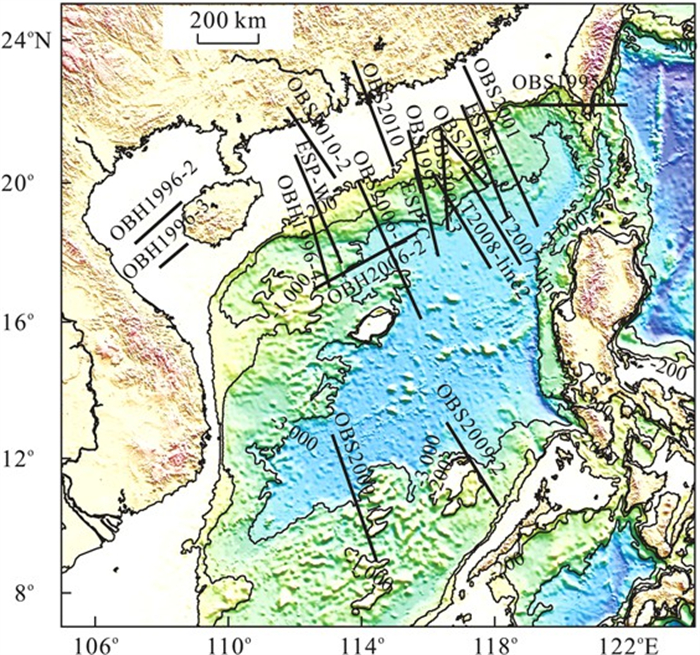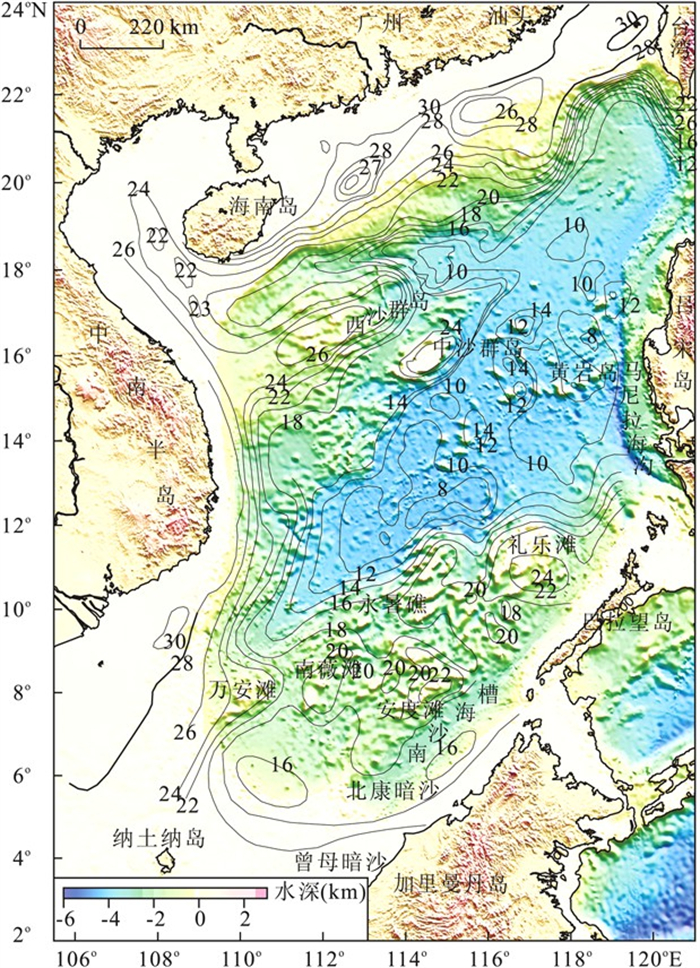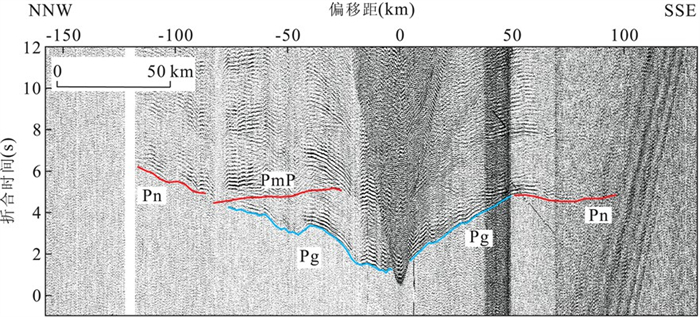Deep Seismic Surveys in the Southern South China Sea and Contrast on Its Conjugate Margins
-
摘要: 南海南部最新深地震探测对于南海南北共轭陆缘的对比研究及南海形成演化理论的研究至关重要.以南海深地震探测发展历程和南海南部区域地质地球物理特征为基础, 借鉴世界上典型共轭陆缘对比研究的方法, 结合2009年新获得的两条海底地震仪测线, 指出了南海南部及深海盆深部结构研究的迫切性与重要性, 并提出西南次海盆的深部结构、洋盆中海山的速度结构与属性及南北共轭陆缘张裂体系, 是今后南海形成演化理论问题的重要突破点.Abstract: The deep seismic surveys in the southern South China Sea (SCS) are of vital importance for conjugate continental margins and the theory of formation and evolution of SCS.This paper firstly reviews the survey history, then analyzes the geological and geophysical characteristics and finally presents the significance of deep structure research in southern SCS based on comparing the conjugate continental margins with Newfoundland and Iberia.Deep structures of the southwestern sub-basin, velocity structures of sea mountains in the deep basin, and the whole rifting system could make breakthrough for the theory of formation and evolution of the SCS in the future.
-
Key words:
- southern South China Sea /
- deep basins /
- sea mountains /
- tectonics /
- deep seismic survey /
- marine geophysics
-
图 2 南沙海域深地震探测位置
红色点为部署的OBS; 灰色点为没有成功回收的OBS; 磁条带、扩张脊及海盆边界数据参考文章Briais et al. (1993)
Fig. 2. Deep seismic experiments in the Nansha area of the South China Sea
图 3 南海重力计算的莫霍面埋深(苏达权, 2002)
Fig. 3. The isobaths of Moho discontinuity calculated by gravity data in the South China Sea
-
[1] Barckhausen, U., Roeser, H. A., 2004. Seafloor spreadinganomalies in South China Sea revisited. In: Clift, P., Wang, P., et al., eds., Continent-ocean interactionswithin East Asian marginal seas. Geophys. Monogr., AGU, Washington, D. C., 149: 121-125. [2] Braitenberg, C., Wienecke, S., Wang, Y., 2006. Basementstructures from satellite-derived gravity field: South China Sea ridge. J. Geophys. Res., 111(B05407): 115. doi: 10.1029/2005JB003938. [3] Briais, A., Patriat, P., Tapponnier, P., 1993. Update interpretation of magnetic anomalies and seafloor spreadingstages in the South China Sea: implications for the Tertiary tectonics of Southeast Asia. J. Geophys. Res. , 98(B4): 6299-6328. doi: 10.1029/92JB02280 [4] Cande, S. C., Kent, D., 1995. Revised calibration of the geomagnetic polarity timescale for the Late Cretaceous and Cenozoic. J. Geophys. Res. , 100(B4): 6093-6095. doi: 10.1029/94JB03098 [5] Chiu, M. X., 2010. The P-wave velocity modeling of the transitional crust in northern South China Sea continentalmargin (Dissertation). Jilong, Institute of Applied Geosciences College of Ocean Science and Resource, National Taiwan Ocean University (in Chinese with Englisha bstract). [6] Funck, T., Jackson, H. R., Louden, K. E., et al., 2004. Crustal structure of the northern Nova Scotia rifted continental margin (eastern Canada). J. Geophys. Res., 109(B09102): 1-19. doi: 10.1029/2004JB003008. [7] Gao, H. F., Zhou, D., Qiu, Y., 2009. Relationship between formation of Zhongyebei basin and spreading of SW subbasin, the South China Sea. Journal of Earth Science, 20(1): 66-76. doi: 10.1007/s12583-009-0007-2. [8] Jin, Q. H., Li, T. G., 2000. Regional geologic tectonics of the Nansha Sea area. Marine Geology & Quaternary Geology, 20(1): 1-8 (in Chinese with English abstract). http://en.cnki.com.cn/Article_en/CJFDTOTAL-HYDZ200001000.htm [9] Li, C. F., Zhou, Z. Y., Li, J. B., et al., 2007. Structures ofthe northeasternmost South China Sea continental margin and ocean basin: geophysical constraints and tectonic implications. Mar. Geophys. Res., 28(1): 59-79. doi: 10.1007/s11001-007-9014-9. [10] Li, C. F., Zhou, Z. Y., Li, J. B., et al., 2008. Magnetic zoningand seismic structure of the South China Sea ocean basin. Mar. Geophys. Res., 29(4): 223-238. doi: 10.1007/s11001-008-9059-4. [11] Li, J. B., Jin, X. L., Gao, J. Y., 2002. Morpho-tectonic studyon late-stage spreading of the eastern subbasin of South China Sea. Sci. China (Ser. D), 45: 978-989. doi: 10.1007/BF02911236 [12] Li, J. B., 2011. The three-dimensional tomogramphy and itstectonic evolution in the southwestern subbasin of South China Sea. The first seminar of South China Sea Deep, Shanghai, 1 (in Chinese). [13] Ludwig, W. J., Kumar N., Houtz R. E., 1979. Profile-Sonobuoy measurement in the South China Sea basin. J. Geophys. Res. , 84(B7): 3505-3518. doi: 10.1029/JB084iB07p03505. [14] Nissen, S. S., Hayes, D. E., Yao, B. C., et al., 1995. Gravity, heat flow, and seismic constraints on the processes ofcrustal extension: northern margin of the South China Sea. J. Geophys. Res., 100(B11): 22447-22483. doi: 10.1029/95JB01868. [15] Péron-Pinvidic, G., Manatschal, G., 2009. The final riftingevolution at deep magma-poor passive marginsfrom Iberia-Newfoundland: a new point of view. Int. J. Earth Sci., 98(7): 1581-1597. doi: 10.1007/s00531-008-0337-9. [16] Qiu, X. L., Shi, X. B., Yan, P., et al., 2003. Recent progressof deep seismic experiments and studies of crustal structure in northern South China Sea. Progress in Natural Science, 13(7): 231-236(in Chinese). [17] Qiu, X. L., Wang, P., Zhao, M. H., et al., 2009. Ocean bottom seismometer experiment in the southern continental margin of the South China Sea, The 25th annual meeting of Chinese Geophysical Society, Beijing, China Science and Techonology University Press, 620 (in Chinese). [18] Qiu, X. L., Ye, S. Y., Wu, S. M., et al., 2001. Crustal structure across the Xisha trough, northwestern South China Sea. Tectonophysics, 341(1-4): 179-193. doi: 10.1016/S0040-1951(01)00222-0000. [19] Ruan, A. G., Niu, X. W., Wu, Z. L., et al., 2009a. The 2D velocity and density structure of the Mesozoic sedimentsin the Chaoshan depression. Geological Journal of China Universities, 15(4): 522-528 (in Chinese with English abstract). http://www.researchgate.net/publication/308314983_The_2D_velocity_and_density_structure_of_the_Mesozoic_sediments_in_the_Chaoshan_depression [20] Ruan, A. G., Qiu, X. L., Li, J. B., et al., 2009b. Wide aperture seismic sounding in the margin seas of China. South China Journal of Seismology, 29(2): 10-18 (in Chinese with English abstract). http://en.cnki.com.cn/Article_en/CJFDTOTAL-HNDI200902004.htm [21] Schluter, H. U., Hinz, K., Block, M., 1996. Tectono-stratigraphic terranes and detachment faulting of the South China Sea and Sulu Sea. Marine Geol. , 130(1-2), 3951, 58-78. doi: 10.1016/0025-3227(95)00137-9. [22] Su, D. Q., 2002. A special investigation report on exclusiveeconomic zone and continental shelf survey. Maritime Press, Beijing (in Chinese). [23] Su, D. Q., Huang, C. L., Xia, K. Y., 1996. The crust in the Nansha trough. Scientia Geologica Sinica, 31(4): 409-415 (in Chinese with English abstract). [24] Taylor, B., Hayes, D. E., 1980. The tectonic evolution of the South China Sea basin. In: Hayes, D. E., ed., The tectonic and geologic evolution of southeastern Asian Seasand islands. Geophys. Monogr., AGU, Washington, D. C., 23: 89-104. [25] Taylor, B., Hayes, D. E., 1983. Origin and history of the South China Sea basin. In: Hayes, D. E., ed., The tectonic and geologic evolution of southeastern Asian Seas and Islands, II. Geophys. Monogr., AGU, Washington, D. C., 27: 23-56. [26] Wan, L., Wu, N. Y., Zeng, W. J., et al., 2004. Crustal structure in Nansha and its adjacent area. Geological Research of South China Sea, 16: 1-9 (in Chinese with English abstract). http://en.cnki.com.cn/Article_en/CJFDTotal-NHDZ200400001.htm [27] Wang, P. X., 2009. Toward scientific breakthrough in the South China Sea. Journal of Tropical Oceanography, 28(3): 1-4 (in Chinese with English abstract). http://en.cnki.com.cn/Article_en/CJFDTOTAL-RDHY200903002.htm [28] Wang, T, K., Chen, M. K., Lee, C. S., et al., 2006. Seismicimaging of the transitional crust across the northeasternmargin of the South China Sea. Tectonophysics, 412(34): 237-254. doi: 10.1016/j.tecto.2005.10.039. [29] White, R. S., McKenzie, D., O'Nions, R. K., 1992. Oceaniccrustal thickness from seismic measurements and rareearth element inversions. Journal of Geophysical Research, 97(B13): 19683-19715. doi: 10.1029/92JB01749. [30] Wu, S. M., Qiu, X. L., Zhou, D., et al., 2009. Crustal structure beneath Yinggehai basin and adjacent Hainan Island, and its tectonic implications. Journal of Earth Science, 20(1): 13-26. doi: 10.1007/s12583-009-0002-7. [31] Wu, Z. L., Ruan, A. G., Li, J. B., et al., 2008. New progressof deep crust Sounding in the mid-northern South China Sea using ocean bottom seismometers. South China Journal of Seismology, 28(1): 21-28 (in Chinese with English abstract). http://en.cnki.com.cn/Article_en/CJFDTOTAL-HNDI200801006.htm [32] Wu, Z. L., Ruan, A. G., Li, J. B., et al., 2010. New progressof deep crust sounding in the southern margin of South China Sea using ocean bottom seismometers. Journal of Marine Science, 28(1): 55-61 (in Chinese with English abstract). [33] Xia, S. H., Zhao, M. H., Qiu, X. L., et al., 2010. Crustalstructure in an onshore-offshore transitional zone near Hong Kong, northern South China Sea. Journal of Asian Earth Science, 37(5-6): 460-472. doi: 10.1016/j.jseaes.2009.11.004. [34] Xu, H. L., Qiu, X. L., Zhao, M. H., et al., 2006. Characteristics of the crustal structure and hypocentral tectonicsin the epicentral area of Nan'ao earthquake(M=7.5), the northeastern South China Sea. Chinese Science Bul-letin, 51(SII): 83-91 (in Chinese). [35] Yan, P., Deng, H., Liu, H. L., et al., 2006. The temporaland spatial distribution of volcanism in the South China Sea region. Journal of Asian Earth Sciences, 27(5): 647-659. doi: 10.1016/j.jseaes.2005.06.005. [36] Yan, P., Liu, H. L., 2004. Tectonic-straigraphic division and blind fold structures in Nansha Waters, South China Sea. Journal of Asian Earth Sciences, 24(3): 337348. doi: 10.1016/j.jseaes.2003.12.005. [37] Yan, P., Wang, Y. L., Liu, H. L., 2008. Post-spreading transpressive faults in the South China Sea basin. Tectonophysics, 450(1-4): 70-78. doi: 10.1016/j.tecto.2008.01.015. [38] Yan, P., Zhou, D., Liu, Z. S., 2001. A crustal structure profile across the northern continental margin of the South China Sea. Tectonophysics, 338(1): 1-21. doi: 10.1016/S0040-1951(01)00062-2. [39] Yan, Q. S., 2008. Geochemistry of Cenozoic alkali basalt from the South China Sea and its geodynamical significance (Dissertation). Chinese Academy of Sciences, Beijing (in Chinese with English abstract). [40] Yao, B. C., 1995. Characteristics and tectonic meaning of Zhongnan-Liyue fault. Geological Research of South China Sea, 7: 1-14 (in Chinese with English abstract). http://en.cnki.com.cn/Article_en/CJFDTOTAL-NHDZ199500000.htm [41] Yao, B. C., 1999. On the lithospheric rifting model in thesouthwest subbasin of the South China Sea. Marine Geology & Quaternary Geology, 19(2): 37-48 (in Chinese with English abstract). http://www.researchgate.net/publication/312786693_On_the_lithospheric_rifting_model_in_the_southwest_subbasin_of_south_China_sea [42] Yao, B. C., Zeng, W. J., Hayes, D. E., et al., 1994. The geological memoir of South China Sea survey jointly by China and USA. China University of Geosciences Press, Beijing, 204 (in Chinese). [43] Zhao, M. H., Qiu, X. L., Xia, S. H., et al., 2010. Seismicstructure in the northeastern South China Sea: S-wavevelocity and Vp/Vs ratios derived from three-component OBS data. Tectonophysics, 480(1-4): 183-197. doi: 10.1016/j.tecto.2009.10.004. [44] Zhao, M. H., Qiu, X. L., Xu, H. L., et al., 2007. The distribution and identification of the low-velocity layer in thenorthern South China Sea. Progress in Natural Science, 17(5): 591-600 (in Chinese). doi: 10.1080/10020070708541040 [45] Zhao, M. H., Qiu, X. L., Ye, C. M., et al., 2004. Analysis on deep crustal structure along the onshore-offshore seismic profile across the Binhai (Littoral) fault zone in northeastern South China Sea. Chinese J. Geophys., 47(5): 845-852 (in Chinese with English abstract). http://www.researchgate.net/profile/Ping_Wang45/publication/260409872_An_Analysis_on_Deep_Crustal_Structure_Along_the_Onshore-Offshore_Seismic_Profile_Across_the_Binghai_(Littoral)_Fault_Zone_in_Ne_South_China_Sea/links/562ec79a08aef25a24445367.pdf [46] Zhou, L. Q., Liu, F. T., Liu, J. S., et al., 2005. Determination of the crustal velocity model of Dongsha islands using the inversion of τ-p wave field. Progress in Geophysics, 20(2): 503-506 (in Chinese with English abstract). http://d.wanfangdata.com.cn/periodical/dqwlxjz200502046 [47] 金庆焕, 李唐根, 2000. 南沙海域区域地质构造, 海洋地质与第四纪地质, 20(1): 1-8. https://www.cnki.com.cn/Article/CJFDTOTAL-HYDZ200001000.htm [48] 李家彪, 2011. 南海西南次海盆中脊3D地震成像及其构造演化. 南海深海过程演变, 上海, 同济出版社, 1. [49] 李家彪, 金翔龙, 高金耀, 2002. 南海东部海盆晚期扩张的构造地貌研究. 中国科学(D辑), 32(3): 239-248. https://www.cnki.com.cn/Article/CJFDTOTAL-JDXK200203008.htm [50] 丘学林, 施小斌, 阎贫, 等, 2003. 南海北部地壳结构的深地震探测和研究新进展. 自然科学进展, 13(3): 231-236. doi: 10.3321/j.issn:1002-008X.2003.03.002 [51] 丘学林, 王平, 赵明辉, 等, 2009. 南海南部大陆边缘的海底地震仪探测. 北京: 中国地球物理学会第二十五届年会论文摘要, 中国科学技术出版社, 620. [52] 邱懋翔, 2010. 南中国海北部大陆边缘之海陆地壳过渡带的P波速度模式(硕士学位论文). 基隆: 台湾海洋大学应用地球科学研究所. [53] 阮爱国, 牛雄伟, 吴振利, 等, 2009a. 潮汕坳陷中生代沉积的折射波2D速度结构和密度. 高校地质学报, 15(4): 522-528. https://www.cnki.com.cn/Article/CJFDTOTAL-GXDX200904011.htm [54] 阮爱国, 丘学林, 李家彪, 等, 2009b. 中国海洋深地震探测与研究进展. 华南地震, 29(2): 10-18. https://www.cnki.com.cn/Article/CJFDTOTAL-HNDI200902004.htm [55] 苏达权, 2002. 我国专属经济区和大陆架勘测专项综合报告. 北京: 海洋出版社. [56] 苏达权, 黄慈流, 夏戡原, 1996. 论南沙海槽的地壳性质. 地质科学, 31(4): 409-415. https://www.cnki.com.cn/Article/CJFDTOTAL-DZKX199604009.htm [57] 万玲, 吴能友, 曾维军, 等, 2004. 南沙及其邻近海域地壳结构特征. 南海地质研究, 16: 1-9. https://www.cnki.com.cn/Article/CJFDTOTAL-NHDZ200400001.htm [58] 汪品先, 2009. 南海—我国深海研究的突破口. 热带海洋学报, 28(3): 1-4. doi: 10.3969/j.issn.1009-5470.2009.03.001 [59] 吴振利, 阮爱国, 李家彪, 等, 2008. 南海中北部地壳深部结构探测新进展. 华南地震, 28(1): 21-28. doi: 10.3969/j.issn.1001-8662.2008.01.003 [60] 吴振利, 阮爱国, 李家彪, 等, 2010. 南海南部海底地震仪试验及初步结果. 海洋学研究, 28(1): 55-61. doi: 10.3969/j.issn.1001-909X.2010.01.008 [61] 徐辉龙, 丘学林, 赵明辉, 等, 2006. 南海东北部南澳大地震(M=7.5)震中区的地壳结构特征与震源构造. 科学通报, 51(SII): 83-91. https://www.cnki.com.cn/Article/CJFDTOTAL-KXTB2006S3015.htm [62] 鄢全树, 2008. 南海新生代碱性玄武岩的特征及其地球动力学意义(硕士学位论文). 北京: 中国科学院研究生院. [63] 姚伯初, 1995. 中南—礼乐断裂的特征及其构造意义. 南海地质研究, 7: 1-14. https://www.cnki.com.cn/Article/CJFDTOTAL-NHDZ199500000.htm [64] 姚伯初, 1999. 南海西南海盆的岩石圈张裂模式探讨. 海洋地质与第四纪地质, 19(2): 37-48. https://www.cnki.com.cn/Article/CJFDTOTAL-HYDZ902.005.htm [65] 姚伯初, 曾维军, Hayes, D. E., 等, 1994. 中美合作调研南海地质专报. 武汉: 中国地质大学出版社, 204. [66] 赵明辉, 丘学林, 徐辉龙, 等, 2007. 南海北部沉积层和地壳内低速层的分布与识别. 自然科学进展, 17(4): 471-479. doi: 10.3321/j.issn:1002-008X.2007.04.008 [67] 赵明辉, 丘学林, 叶春明, 等, 2004. 南海东北部海陆深地震联测与滨海断裂带两侧地壳结构分析. 地球物理学报, 47(5): 845-852. doi: 10.3321/j.issn:0001-5733.2004.05.016 [68] 周龙泉, 刘福田, 刘劲松, 等, 2005. 利用τ-p波场反演法确定东沙群岛的地壳速度模型. 地球物理学进展, 20(2): 503-506. doi: 10.3969/j.issn.1004-2903.2005.02.046 -










 下载:
下载:




